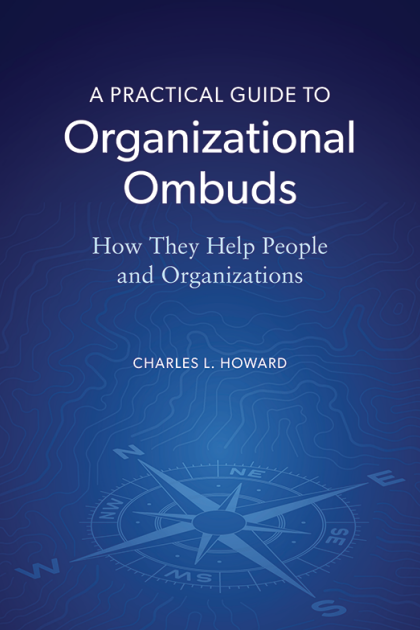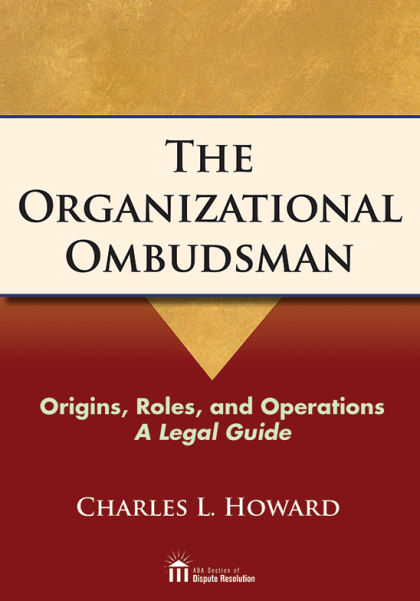A Practical Guide to Organizational Ombuds: How They Help People and Organizations
The wait is over! After more than a year of research and with the participation of many IOA members, Chuck Howard’s new book, A Practical Guide to Organizational Ombuds: How They Help People and Organizations, is going on sale this month.
It is the second book by IOA’s executive director and follows his seminal work, The Organizational Ombudsman: Origins, Roles and Operations - A Legal Guide, published in 2011, which has since become an essential resource for ombuds, dispute resolution professionals, in-house counsel, corporate executives, university administrators, compliance officers, and human resources personnel.
Where his first book provided a history of the evolution of the role of an organizational ombuds and explained the function, Chuck’s new release is a practical guide for anyone with questions about what ombuds programs are and how they operate.
“Many people and organizations do not understand what organizational ombuds are and how they work,” says Chuck. “When confronted with requests to create these programs, those in charge often raise questions about the need for yet another overhead expense that does not produce revenue. They want to know what value these programs really add, and they frequently express skepticism about ombuds' claim of confidentiality and how these programs can operate independently within an organization when an ombuds may be an employee of the organization.”
 Part I
Part I
Part I of A Practical Guide presents expert responses to these common concerns about ombuds programs and responds directly to the many difficult questions that the author has been asked over the years—questions about what organizational ombuds offices are, why they fill a need that other functions cannot address, why confidentiality is important, and why the office's structure is important to achieving that confidentiality.
Part II
Part II uses real-world examples to illustrate the unique value that ombuds provide and recounts actual examples of what ombuds do.
“These are real, anonymized examples provided by real ombuds – not composite or hypothetical,” says Chuck “Better than any abstract discussion, these examples make plain the unique value that ombuds programs provide.”
Organized in more than 30 categories such as “Difficult Bosses,” “Navigating Bureaucracy,” “Sexual Harassment” and “Cross-Cultural Issues,” Chuck walks the reader through real-life stories of ombuds in action, presenting more than 200 pages of examples in the printed version and a full compilation of over 600 pages available in digital format.
Take the case of one high-level leader, for example, from the “Senior Management” chapter:
She had been told three times by her manager that she was going to get a considerable salary increase after agreeing to take on an additional role. She had now been waiting three months for the increase to take place, and when she checked with HR, she was told that her boss had yet to complete the needed paperwork. This leader was particularly nervous because her manager was known to be a difficult person who played favorites, sidelined people when challenged, and wielded a lot of power.
She and the ombuds spent considerable time talking about the nature of previous conversations with her manager, whether or not there was a written record of the conversation to obtain an increase in salary, and the organization’s policy and procedure for short-term pay increases. After ninety minutes, she said she was ready to approach her manager again, and one month later reported that the salary increase had gone through.
“There is nothing like a story to illustrate a point and transform knowing into understanding,” writes the author in Part II. “Even a cursory review of the examples collected from around the world and in many different types of organizations reveals a universality to both the need for this resource and the helpful ways ombuds can assist individuals and organizations with the issues involved.”
A Practical Guide to Organizational Ombuds: How They Help People and Organizations is available online through the American Bar Association.
ABA members and Section on Dispute Resolution members will receive a discounted rate on their purchase. Now is a great time for IOA members to take advantage of their discounted membership rate. You do NOT need to be an attorney to participate. To secure the discounted rate, Ombuds who are licensed attorneys may join as a nonprofit/public lawyer. Non-lawyers may join as an Affiliated Professional. Learn more now.
|
|
|
|||
Place Your Order Now |
Place Your Order Now |


